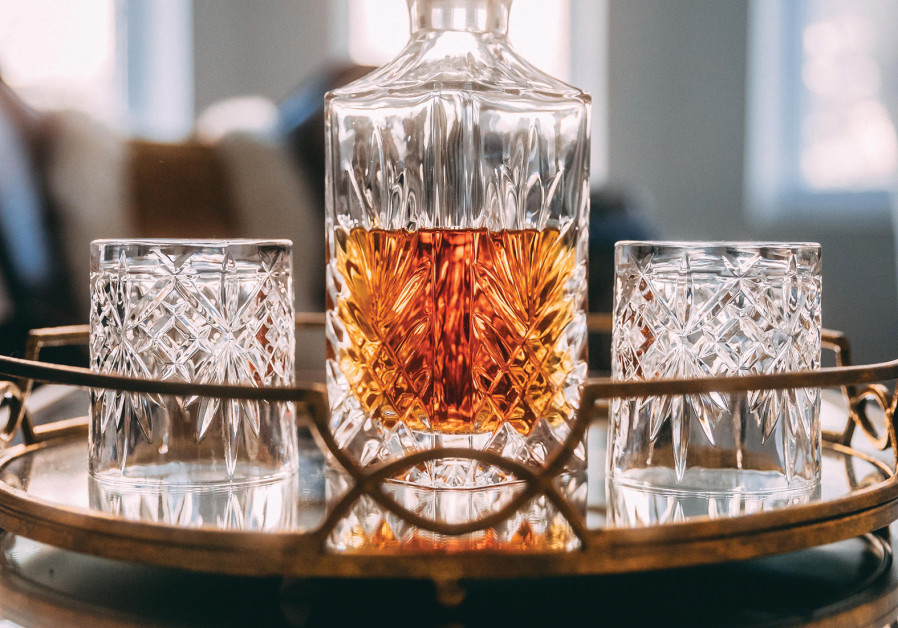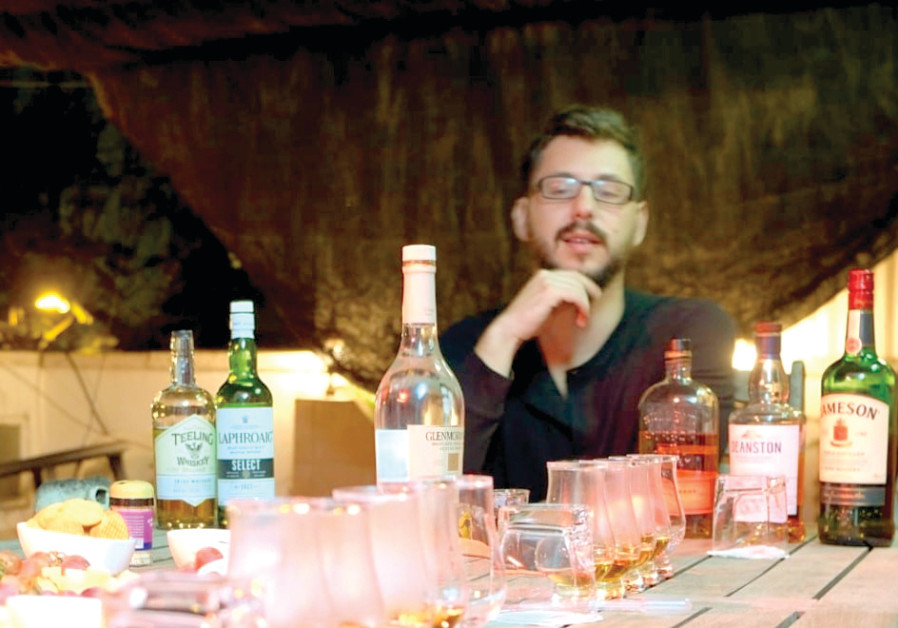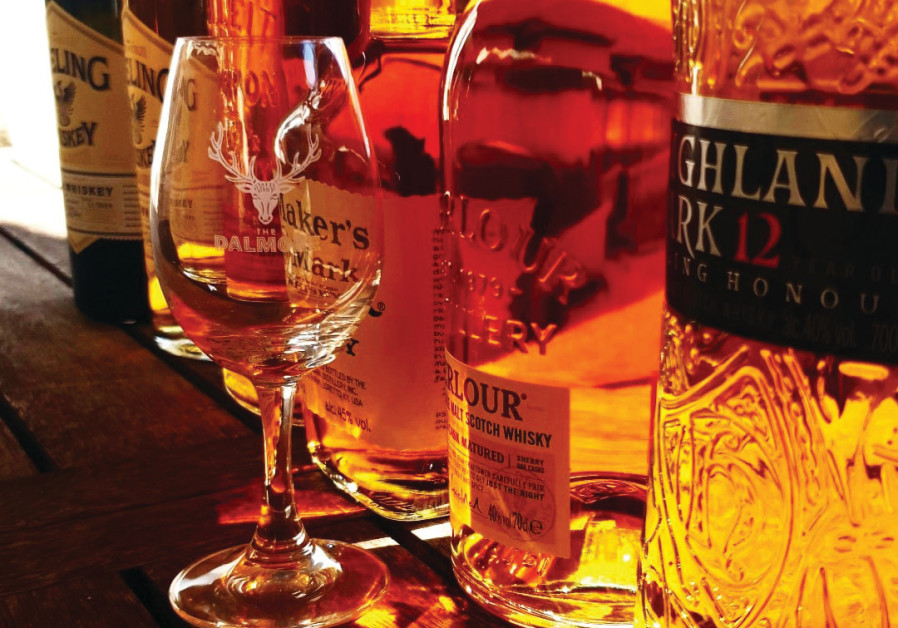It took all of two minutes to dispel that illusion, as I was introduced to a far more expansive and diverse world than I had ever considered, and the boundaries of good taste opened up appreciably.
The 25-year-old Jerusalemite, tenderness of years notwithstanding – I am a full four decades his senior – has a vast knowledge of the nuances, inner machinations and sheer beauty of the amber nectar.
Appelbaum exudes unbridled passion for the beverage.
“I am studying for a degree in chemistry and materials science because I believe that will provide me with a deeper understanding of what goes into making whisky,” he states up front.
I quickly realized that my 20-plus array of Scottish, Irish, English, Japanese and even Israeli brews paled into abashed insignificance against the Jerusalemite’s 200-strong collection. And there were names in there I’d never even heard of, and ingredients I’d never imagined. One rundown of components, for example, featured an enticing fusion of “Indian barley and Scottish barley.” Not a combo I had ever envisaged.

Then again, if you’re going to illuminate others about the ins and outs of the industry and the market, and advise people with regard to the attributes of this or that variety, you have to know your stuff. And that is exactly what Appelbaum does, running whisky workshops for individuals and groups in the comfort of their own homes, and at neutral venues, all over the country.
To say my session with the young man was an eye-opener would be a gross understatement. I came away from his place with enhanced understanding and greater appreciation of one of the world’s most popular drinks, with my palate recalibrated and ready for new alcoholic adventures.
Appelbaum’s font of knowledge seemed inexhaustible as I ran my disbelieving eye over the enormous spread of bottles lovingly displayed in showcase cabinets in his large living room and dining area.
“I don’t know Laphroaig Select,” I note to my instructor for the evening.
“It’s pretty nice,” he comments. “It doesn’t have a stated age. It’s about the same price as the 10-year-old and is stored in barrels of two sorts of sherry, and of port,” comes the quick-fire educated reply.
Most whisky fans with a penchant for the peaty side of the beverage are familiar with the 10-year-old, but the Select variety is less well known to us unwashed masses who simply enjoy our tipple.
As a self-confessed single malt snob, I was right royally put in my place as I continued to survey some of the dozens of bottles arranged with military precision in the voluminous glass-fronted repository.
“That’s Great King Street. It’s a blending company called Compass Box founded by an American in 2000, but they are Scottish, working out of Glasgow. They make superb blends,” Appelbaum explains.
That was quite a shake-up moment for Yours Truly.
“That’s 67% Laphroaig,” he adds, pointing at a bottle with the ominous title of The Peat Monster. “It is 46% proof. It is the exact strength so that you don’t need chill filtration.”
That was a term I’d not come across before. What did it mean? I was to discover the crucial importance of avoiding that element of the production process later on in our workshop session. I learned that, while chill filtration eliminates haze forming in whisky, it also has a detrimental effect on the flavor.
Appelbaum lined up an intriguing bunch of brews for me to sample, as part of the instructional main course.
But, before we got started in earnest, he made sure my palate was ready for the deftly crafted works of art he had set up on the dining table, by providing a chaser – 18-year-old Chivas Regal, if you must know.
That provided yet another opportunity to enlighten me about some of the more obscure subtext to the art of drinking and appreciating fine booze.
“This is about the retronasal effect. When we drink alcohol, it evaporates. As soon as it descends [through the body] it rises back up and collects behind our olfactory sensors. As soon as that happens, we get used to the taste of alcohol, and that makes it a lot easier to taste all the flavors.”

“For me, whisky is the perfect combination of art and science,” Appelbaum declares.
That stands to reason. Naturally, there is all manner of technical and technological aspects of the process of producing whisky that have to be spot-on. But then there are the delightful, more amorphous and mysterious factors that go into creating a fine batch of the alcoholic beverage.
My more romantic side is piqued when I think of the smaller, family-run distilleries – as far away as one can possibly get from the likes of the industrialized commercial giant Johnny Walker brand, for example. I fancifully imagine some Angus McKinley – for want of a better stock Scottish moniker – passing down the secret recipe, of what has been a family heirloom for generations, to his eldest male offspring just before he moves on to the celestial barroom.
Appelbaum seems to have the scientific-technical side to the art of whisky making, and the appreciation of the bottled outcome thereof, down pat.
When I ask him what nibbles he opts for between slurps, he says he goes for cheese of various strengths, and salmon, explaining: “The aim is the fat molecules envelop the tongue. That’s because the ethanol penetrates through the tongue tissues and directly accesses the pain receptors. If you coat them with fat from, in this case, coconut, it is much easier for you to appreciate other flavors that are not ethanol.”
Go figure.
Technical knowledge notwithstanding, Appelbaum says he is not out to blind anyone with science. “I tailor the workshops to my audiences.”
I experienced that firsthand as he laid on an intriguing multinational selection for my epicurean delight. My personal workshop featured a couple of Irish brews – a triple distilled fruity concoction called Sexton and smoky-honeyed Blackpitt – and an English creation by the name of Cotswolds. I had no idea the English made whisky.
That also applied to the origin of the next bottle in the lineup, a fruity offering from France called Brenne, and the improbably titled Glenmorangie – A Tale of Cake. I wasn’t exactly turned on by the appearance of the latter, which was adorned with a label that looked like it had been designed in the heyday of the disco era. But tasting is believing, and I was blown away by the sweet, smooth and daintily smoky flavors that found their way down my gullet.
The six-parter ended on a local crescendo, with the excellent Yerushalmi whisky distilled on a religious moshav by the name of Zanoach, just down the road from my own moshav, not far from Beit Shemesh.

BY THE time he was 18, Appelbaum was a slick hand at mixing cocktails, and even began sharing his expertise with others at workshops.
He gravitated into the more rarefied air of the whisky sector, and says he has followed the upturn in the local market closely and happily.
“I see the distilleries that now send whisky here from abroad, and the whiskies that are made in Israel, and I am impressed. The whole drinking culture in this country has changed markedly in the last few years,” he notes, “and, in my own way, I am trying to do my bit to help,” he adds with a chuckle.
Trying my hand at the half-cocked psychologist pitch, I asked whether the growing interest in what he offers might have anything to do with the pandemic fallout. Could, for example, it have anything to do with escapism?
“I think people are now looking more for a concept evening,” he posits. “I have done birthday party slots for 60-year-olds, 50-, 40- and even 22-year-olds. I sometimes get phone calls from people who are in town at a hotel and ask me to come over with my kit, to give them something out of the ordinary.”
And he’s all set to hit the road and bring his expertise to budding whisky mavens anywhere around the country, at the drop of a hat.
“I have a custom-made case with room for 60 glasses and eight bottles,” he explains. “All the equipment laid out here on the table goes into my case.”
On the subject of supping one’s whisky straight or with supplements, such as water or ice, I was disabused of my dim view of adding water to whisky.
My line of argument had always been, if it’s good whisky, why dilute it? and if it isn’t good whisky, why drink it in the first place?
Betwixt the stellar rollout of whisky bottles and tasty tidbits – he considerately catered to my vegan dietary requirements – including a spread of cheeses and chocolate, I noted a small pipette next to one of the cheese platters, and was told that, when administered in the right proportion – around three or four drops to a shot – water can help to coax the flavors out of the alcohol. I’ll try that sometime.
A quick word for the doubters in relation to whisky made in Israel. I must admit that a couple of years back, I ordered a bottle of locally made whisky and was disappointed with the product. But things have changed for the better, and how!
The aforementioned Yerushalmi makes for a fine drinking experience, and Appelbaum says we steal a march on distillers in more temperate parts of the world. “Because of the weather here, Israeli whisky, after three years, attains colors and flavors of whisky that has aged 12-15 years [abroad]. The Yerushalmi we are drinking here, I reckon, is around one year and four months old. The weather in the Jerusalem Hills, because of the fluctuation in temperatures, does it wonders.”
The Milk and Honey distillery – the company website claims it is the industry pioneer in these parts – says Appelbaum, produces particularly fine goods. “I have five types of their single cask, and I have two more on order.”
The price, at least on the starter rung, seems to be right, too. “They cost around NIS 250. Their cask strength comes in at about NIS 400.”
I left Ramat Beit Hakerem with a spring in my step, and not just because of the fine beverages I’d imbibed. I came away better informed and more appreciative of the incredible range of flavors, textures and shades the rich world of whisky has to offer.
Cheers.
